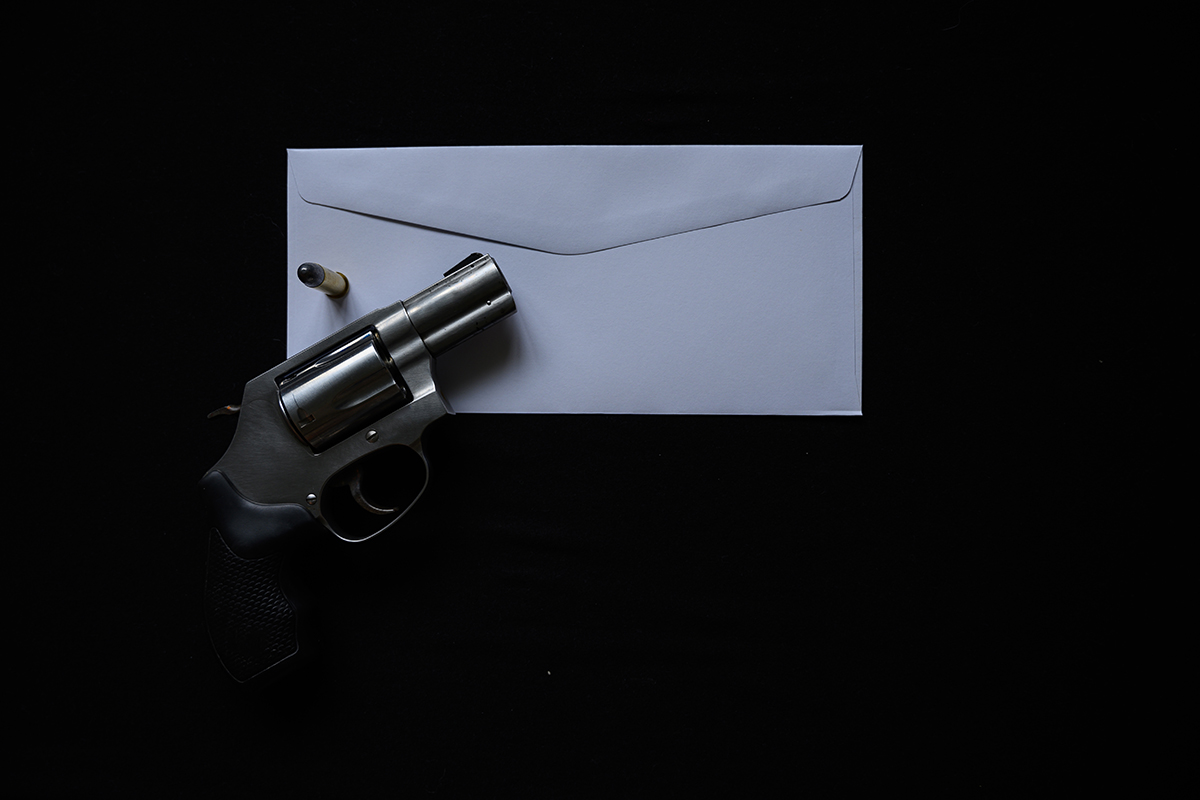In business, when writing to clients, stakeholders, employees, or another company, it’s important to use the right type of letter formatting. Any professional correspondence should be done using a Business Letter Format.
How to Write a Business Letter?
To begin with, such letters should be written on the company’s letterhead. There should be between 1 to 1.5 inches of a margin on all sides of the page. There are basic elements that all such documents should have:
- Contact details of the sender
- Date
- Recipients address
- Salutation
- Main body
- Closing
- Enclosures/Attachments
- Typist’s initials
Senders contact details
If your company’s letterhead already has the business address, it isn’t necessary to repeat this in the sender’s contact details. The same goes for writing your title and name, as this will be at the closing of the letter.
Date
The date should be written one line under the address of the sender unless you are using company letterhead. In this instance, you would leave a 2-inch space from the top of the letterhead and place your date there. This should be aligned to the left of the page. Also, if you are writing to someone in another country, be sure to use their date format. For example, the United Kingdom format is day/month/year, whereas the United States is month/day/year.
Address of the recipient
The line under the date is where you will place the address of the recipient. You should use any name titles in the address (i.e., Dr., Mr., Mrs., Ms.). The address should be written as follows, with each part of the address on its own line:
- Name of recipient
- Title of recipient
- Name of the company
- Company’s street address
- Company’s city, state, and zip code
Salutation
The purpose of the salutation is to create the impression you want to make on the recipient and should be done using their last name, for example, Dear Ms. Smith. If you use the recipient’s first name normally, you can add this to the salutation (Dear Ms. Margaret Smith). Using just the first name should only be done if you are on familiar terms with the recipient. If you are not sure of the gender of the recipient, you can leave the title out (Dear Alex Jones).
Main Body
Leave a space after the salutation and begin the body of the letter on the next line. The body should be professional, precise, and to the point. Only include information that is relevant and use a formal tone. The body of a letter usually consists of 2 or 3 paragraphs, using a block format (double-spacing) between each paragraph.
It should have the following structure:
- Paragraph 1 – should contain the purpose of your letter.
- Paragraph 2 – should include all of the relevant details regarding the purpose of the letter, such as orders, requests, information, or feedback that allows the recipient to make a decision.
- Paragraph 3 – should be a summary of the purpose of the letter and should request action to be taken by the recipient. You should also add a thank you for the recipient’s time and consideration of your request.
Closing
Your closing should be written one line below the last paragraph, with the first word capitalized (Thank you, Kind regards, etc.). If the document requires the recipient’s signature, leave a gap of 4 lines and then your name one line beneath this.
Typist’s initials
If someone else has written a letter to you, their initials should be included at the end of the letter, but before any enclosures, and they should include initials for both the writer of the content and the typist.
Enclosures/attachments
Under this area, you will mention any attachments or enclosures that you have sent with your letter. Make sure you list each attachment that you are sending with your letter (invoice, reference list, resume, etc.)
Free Templates
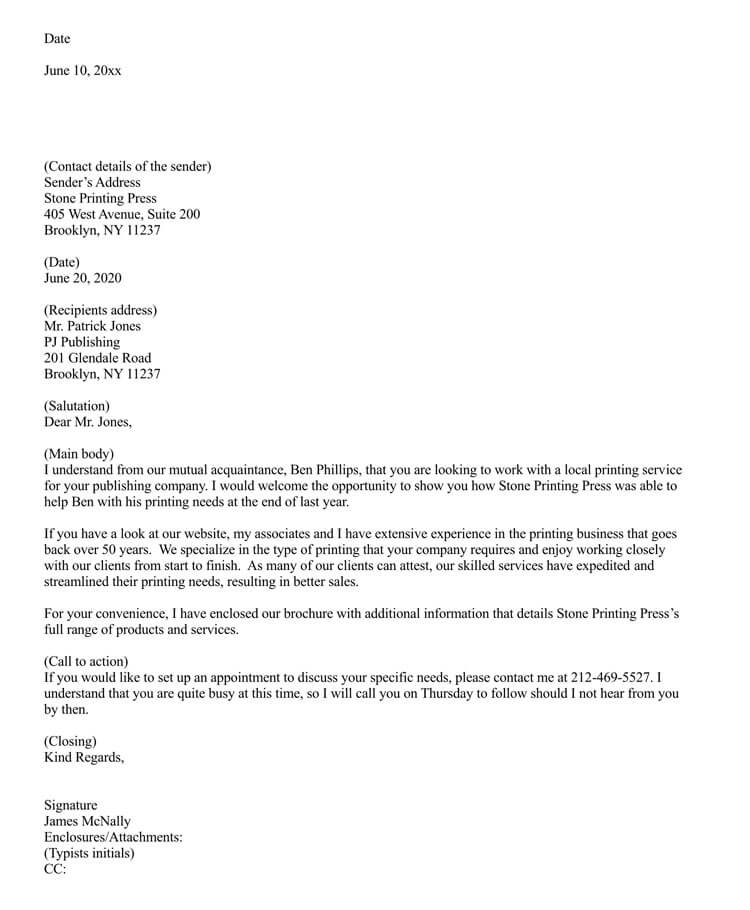
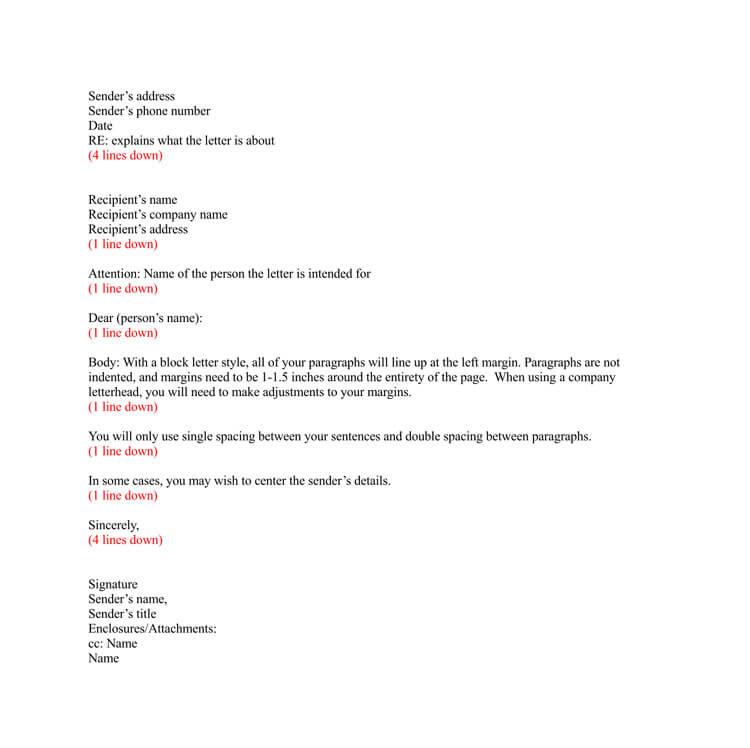
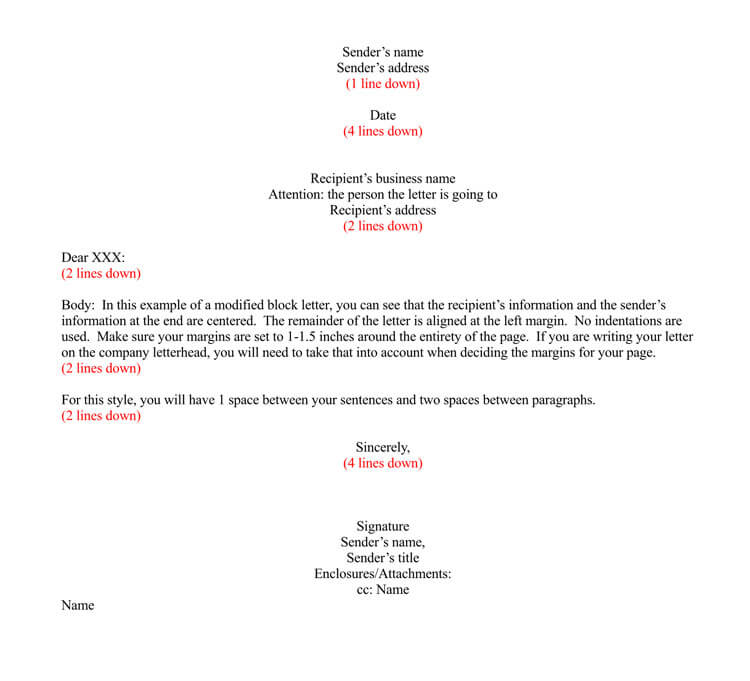
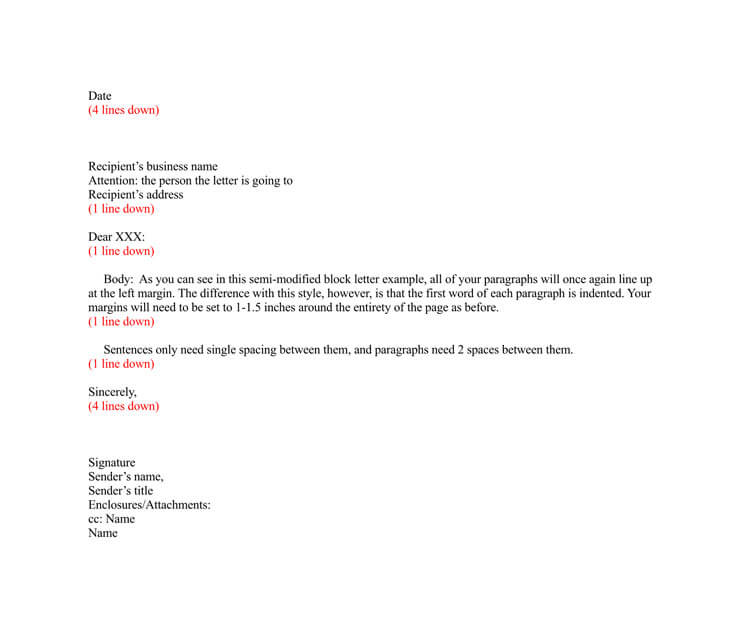
Which Format to Choose?
An acceptable business letter needs to be written in block or modified-block format, as shown above. Semi-block formatting should be avoided for more formal business documents, as it can look a bit unprofessional and less formal. Use acceptable fonts (see below) and avoid using any type of creative font, as this can also give an unprofessional look to your letter.
Standard Business Letter Format Example
(Date)
June 10, 20xx
(Contact details of the sender)
Sender’s Address
Stone Printing Press
405 West Avenue, Suite 200
Brooklyn, NY 11237
(Date)
June 20, 20XX
(Recipients address)
Mr. Patrick Jones
PJ Publishing
201 Glendale Road
Brooklyn, NY 11237
(Salutation)
Dear Mr. Jones,
(Main body)
I understand from our mutual acquaintance, Ben Phillips, that you are looking to work with a local printing service for your publishing company. I would welcome the opportunity to show you how Stone Printing Press was able to help Ben with his printing needs at the end of last year.
If you have a look at our website, my associates and I have extensive experience in the printing business that goes back over 50 years. We specialize in the type of printing that your company requires and enjoy working closely with our clients from start to finish. As many of our clients can attest, our skilled services have expedited and streamlined their printing needs, resulting in better sales.
For your convenience, I have enclosed our brochure with additional information that details Stone Printing Press’s full range of products and services.
(Call to action)
If you would like to set up an appointment to discuss your specific needs, please contact me at 212-469-5527. I understand that you are quite busy at this time, so I will call you on Thursday to follow up should I not hear from you by then.
(Closing)
Kind Regards,
Signature
James McNally
Enclosures/Attachments:
CC:
Template Business Letter Format
[Your Name]
[Your Job Title]
[Your Company/Organization Name] (if applicable)
[Your Street Address]
[City, State, Zip Code]
[Your Email Address]
[Your Phone Number]
[Date]
[Recipient’s Name]
[Recipient’s Job Title]
[Recipient’s Company/Organization Name]
[Recipient’s Street Address]
[City, State, Zip Code]
Dear [Recipient’s Name],
I am writing on behalf of [Your Company/Organization Name], [brief description of your company/organization, e.g., “a leading provider of innovative tech solutions”], to inquire about [specific product, service, or business opportunity you’re inquiring about]. [Mention how you learned about the recipient or their offerings, if applicable, e.g., “I came across your company at the XYZ industry conference last month,” or “Your product/service was highly recommended by…”].
We are currently exploring [state the purpose of your inquiry, e.g., “new vendors for our upcoming product line,” “expanding our service offerings,” “partnerships with leading tech service providers”]. I believe that [Recipient’s Company Name] could play a crucial role in this venture due to your renowned [products, services, reputation, etc.].
Could you please provide detailed information on the following aspects:
[Specific information or details you are seeking, e.g., product specifications, pricing information, delivery schedules, etc.]
[Another detail or question]
[Additional inquiry or requirement]
We are particularly interested in [any specific features, services, or terms you are looking for], as these are critical to our [project, product development, service expansion, etc.]. Additionally, [mention any specific preferences or requirements, e.g., “we prefer environmentally friendly products,” “we require flexible delivery schedules”].
Please let me know if you require further details about our inquiry or if there are forms or applications we need to complete. We are keen to explore how your [products/services] can meet our needs and how we can establish a mutually beneficial relationship.
Thank you for considering our inquiry. I look forward to your detailed response and hope to discuss this exciting possibility further. Please feel free to contact me directly at [Your Phone Number] or [Your Email Address].
Sincerely,
[Your Signature] (if sending a hard copy)
[Your Typed Name]
[Your Job Title]
[Your Company/Organization Name] (if applicable)
Typist Initials: [Your initials] (If you typed the letter yourself, this is not necessary. If someone else typed the letter for you, their initials should be included here in lowercase letters.)
Enclosures: [List each document you are including with the letter. Use a brief description for each, e.g., “Enclosed: Product Brochure, Price List, Project Proposal.”]
Sample Business Letter
Dear Ms. Chen,
I am writing to you as the owner of Rossi’s Italian Bistro, a well-loved establishment in Foodville, renowned for our authentic Italian cuisine and commitment to quality ingredients. As we are in the process of expanding our kitchen facilities, we are exploring advanced refrigeration systems that can meet our specific needs for ingredient storage and preservation.
Having heard of CoolTech Refrigeration Solutions’ reputation for reliability and innovation in the refrigeration industry, I am keen to learn more about your products and how they might benefit our restaurant. Specifically, we are interested in refrigeration units that are efficient, environmentally friendly, and capable of maintaining precise temperature control for a wide range of ingredients, from delicate vegetables to robust meats.
Could you please provide detailed information on the following:
- Product Range: An overview of your refrigeration systems suitable for a medium-sized restaurant kitchen, including any models designed for specific types of food storage.
- Energy Efficiency: Data on the energy efficiency ratings of your systems, as we prioritize sustainability and cost-effectiveness in our operations.
- Temperature Control Features: Information on the temperature control technologies used in your refrigeration units, including any smart features for monitoring and adjusting settings remotely.
- Installation and Maintenance: Details on the installation process, ongoing maintenance requirements, and any included support services.
- Pricing and Financing Options: A pricing guide for your recommended models, along with information on any financing plans or leasing options available.
Our goal is to implement a refrigeration solution that not only enhances the efficiency of our kitchen operations but also supports our dedication to offering the highest quality dining experience. We believe that upgrading our refrigeration system is a key step in achieving this objective.
I would appreciate the opportunity to discuss our needs in more detail and explore how CoolTech Refrigeration Solutions can provide the ideal refrigeration system for Rossi’s Italian Bistro. Please let me know if you require further information about our requirements or if there are preliminary forms or consultations that we need to arrange.
Thank you for considering our inquiry. I look forward to your prompt response and hope to establish a beneficial partnership with CoolTech Refrigeration Solutions. Please feel free to contact me directly at (555) 678-1234 or via email at mario@rossisbistro.com.
Sincerely,
Mario Rossi
Owner, Rossi’s Italian Bistro
3 Styles to Format a Business Letter
There are 3 ways in which you can write it:
- Block Format – the entirety of the letter is aligned to the left, uses single spacing, and double spacing between paragraphs.
- Modified Block Format – in this format, the sender’s, recipient’s, and body are aligned to the left and use single spacing. The date and closing of the letter, however, are located at the center of the page.
- Semi Block Format – this is similar to the modified block format. However, every paragraph is indented.
Block Format Example
Sender’s address
Sender’s phone number
Date
RE: explains what the letter is about
(4 lines down)
Recipient’s name
Recipient’s company name
Recipient’s address
(1 line down)
Attention: Name of the person the letter is intended for
(1 line down)
Dear (person’s name):
(1 line down)
Body: With a block letter style, all of your paragraphs will line up at the left margin. Paragraphs are not indented, and margins need to be 1-1.5 inches around the entirety of the page. When using a company letterhead, you will need to make adjustments to your margins.
(1 line down)
You will only use single spacing between your sentences and double spacing between paragraphs.
(1 line down)
In some cases, you may wish to center the sender’s details.
(1 line down)
Sincerely,
(4 lines down)
Signature
Sender’s name,
Sender’s title
Enclosures/Attachments:
cc: Name
Name
Modified Block Format Example
Sender’s name
Sender’s address
(1 line down)
Date
(4 lines down)
Recipient’s business name
Attention: the person the letter is going to
Recipient’s address
(2 lines down)
Dear XXX:
(2 lines down)
Body: In this example of a modified block letter, you can see that the recipient’s information and the sender’s information at the end are centered. The remainder of the letter is aligned at the left margin. No indentations are used. Make sure your margins are set to 1-1.5 inches around the entirety of the page. If you are writing your letter on the company letterhead, you will need to take that into account when deciding the margins for your page.
(2 lines down)
For this style, you will have 1 space between your sentences and two spaces between paragraphs.
(2 lines down)
Sincerely,
(4 lines down)
Signature
Sender’s name,
Sender’s title
Enclosures/Attachments:
cc: Name
Name
Modified Semi-block Format example
Date
(4 lines down)
Recipient’s business name
Attention: the person the letter is going to
Recipient’s address
(1 line down)
Dear XXX:
(1 line down)
Body: As you can see in this semi-modified block letter example, all of your paragraphs will once again line up at the left margin. The difference with this style, however, is that the first word of each paragraph is indented. Your margins will need to be set to 1-1.5 inches around the entirety of the page as before.
(1 line down)
Sentences only need single spacing between them, and paragraphs need 2 spaces between them.
(1 line down)
Sincerely,
(4 lines down)
Signature
Sender’s name,
Sender’s title
Enclosures/Attachments:
cc: Name
Name
Tips From the Professionals
There are some important tips that will help make your document look more professional:
Proofreading
It’s important to go over your letter once you have completed it to check for any errors, such as misspellings, punctuation, and grammatical errors. A letter can be well presented but be dismissed if it is full of errors. It’s a good idea to have one other person proofread your letter as well, just to be certain nothing has been missed.
Personal pronouns
Even formal document make use of personal pronouns. It is, after all, correspondence between two individuals. Be sure to use personal pronouns when you are referring to yourself or the recipient in the entirety of your letter: I am contacting you in regards to, We appreciate your kind consideration. You should always refer to yourself as “I,” the recipient as “you,” and the company or organization as “we”.
Letter length
Bear in mind that when writing it, you want to keep it brief and to the point. Time is essential in business, and no one wants to spend time trying to figure out what it is you are trying to say. Keep your sentences short and professional and avoid using so much formality that your letter becomes tiresome to read and long-winded.
Getting to the point
As mentioned above, time is precious in business. No one has time to try and decipher what your letter is about. Don’t assume the recipient will be able to read between the lines. You want to use a direct approach and take care not to stray from the point of the topic of your letter. Don’t use generalizations or be vague and be sure to state exactly what it is you are needing or expecting of the recipient.
Show them what you’ve got
One thing to keep in mind, depending on the type of letter you are writing, is that it isn’t about you. What we mean by that is, your letter should focus on what you are able to offer the recipient. For example, a letter applying for a job or offering a service should tell the recipient what it is that you can offer them that makes you unique.
Easy terminology
Try to use terminology that is easy for all people to understand. Using too much professional or technical terminology can be confusing and cloud the purpose of your letter. Don’t use a lot of buzz words and jargon, as this makes the letter sound less professional.
Fonts
Be sure to pay attention to the type of font you are using when writing it. Even using the exact form, the wrong font can throw the letter off and make it look less professional. The majority of businesses prefer the Ariel or Times New Roman Font and a 12 font size.
Letterhead
Using your company letterhead gives your letter a polished and professional look, so always use company letterhead for business and formal letters. You want to make the best impression, so be sure your letterhead has been printed on good quality paper and not your average copy machine variety. Also, make sure you have included contact details in your letter at the end, where you will be placing your call to action. Include your website, email address, and contact phone number.
Frequently Asked Questions
The closing you choose for your letter will depend on how formal it is. The simplest closings that can be used in all situations are Regards, Sincerely, Yours sincerely, or Yours truly.
If your letter is a bit more personal, you can use: Cordially, Best regards, or Yours respectfully. Other closings that you can use when you are more familiar with the recipient are With appreciation, Best wishes, and Warm regards.
Most standard documents use block style formats that have the entire letter aligned to the left.
The 3 common formats used for it are block format, modified block format, and semi-block format.



